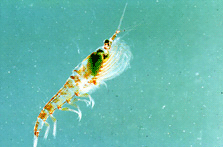
A decline in krill catches in 1992 has been attributed to economic factors rather than a decline in the stocks of krill being fished. Such factors include a shift in fishing effort from krill fisheries to finfish fisheries, and the break-up of the Soviet Union which until then had dominated the fishery. In 1998 the economic crisis in Asia also appears to have further reduced the demand for krill. However, recent advances in harvesting and processing technology along with the development of pharmaceutical krill products may result in a resurgence of commercial krill fishing.
Vessels targeting krill aggregations on island shelves or close to shelf breaks are closely monitored. In many cases krill fishing is conducted close to the breeding sites of land-based krill predators such as penguins. Concern has been expressed that krill catches in such areas may affect predators by locally depleting their food source. The interaction between krill fisheries and land-based krill predators is a focus of CEMP. A synoptic survey of krill in Area 48 (CCAMLR-2000 survey) was conducted in 2000 to update available estimates of krill biomass in the region and to improve inputs into the biological model used to estimate precautionary catch limits for the fishery.
Further reading
Everson, I. (Ed.) (2000). Krill biology, ecology and fisheries. Fish and Aquatic Resources, Series 6. Blackwell Science Ltd., Oxford.
Nicol, S. and Y. Endo. (1999). Krill fisheries: Development, management and ecosystem implications. Aquatic Living Resources, 12 (2): 105–120.
Hewitt, R.P. et al. 2002. Setting a precautionary catch limit for Antarctic krill. Oceanography, Vol. 15, No. 3.